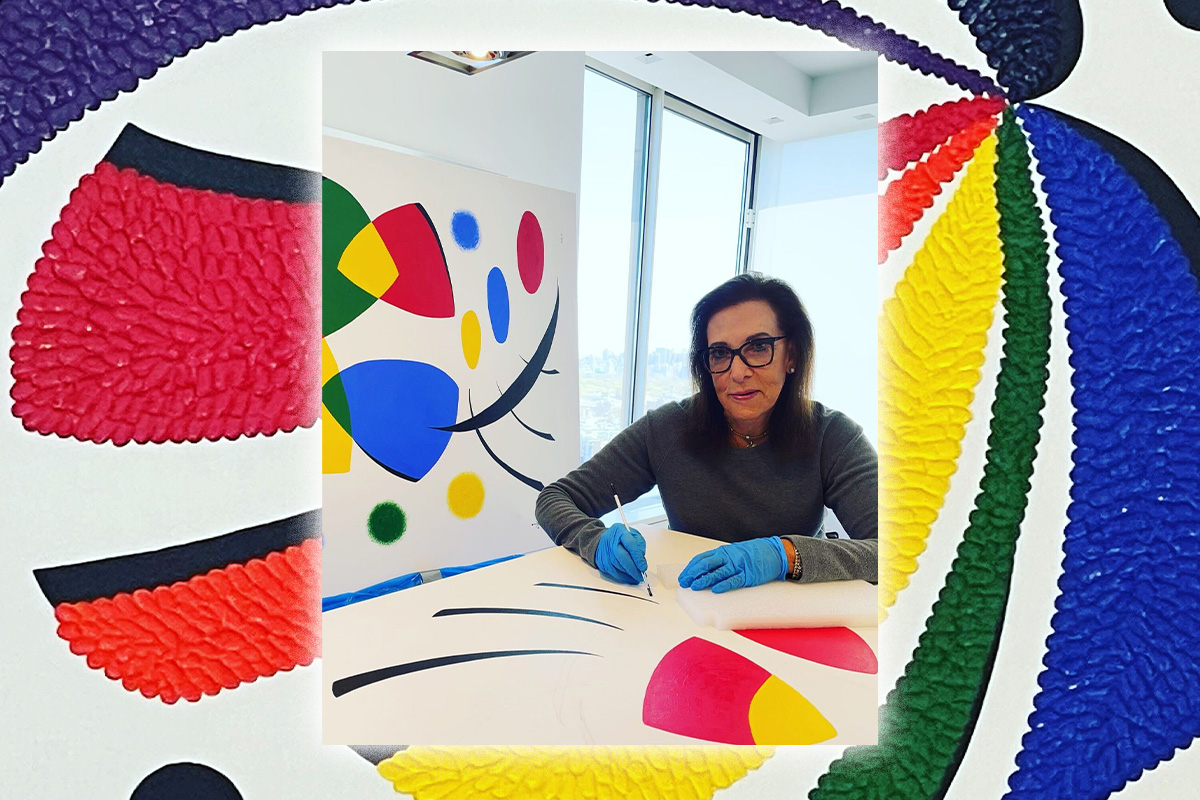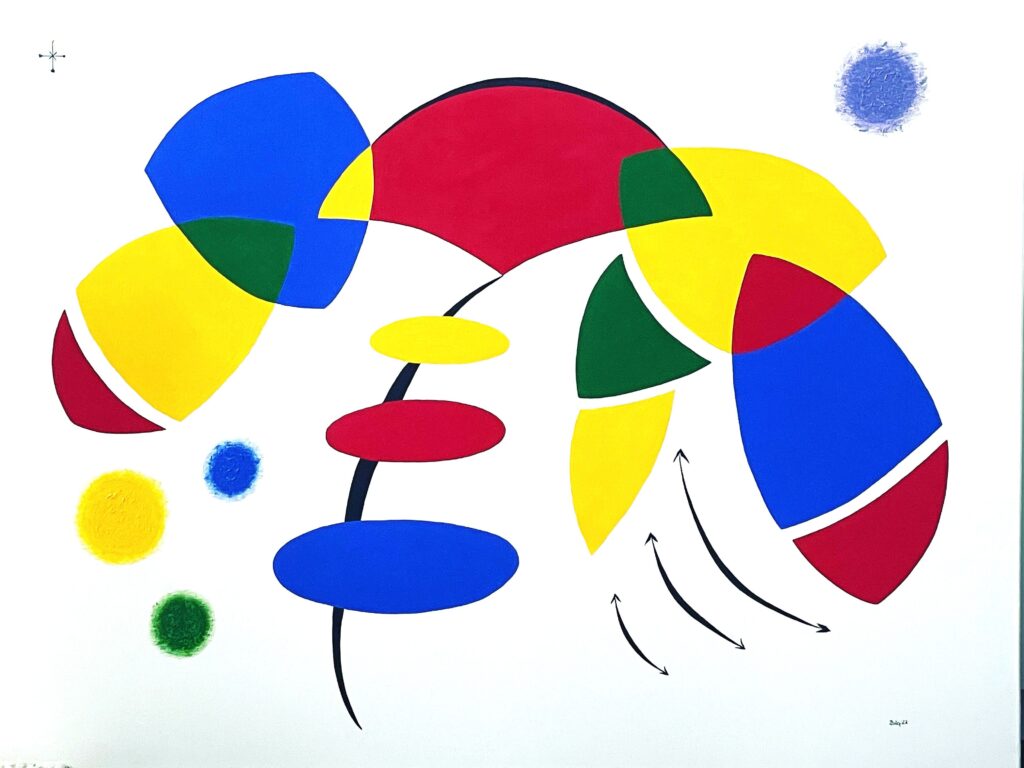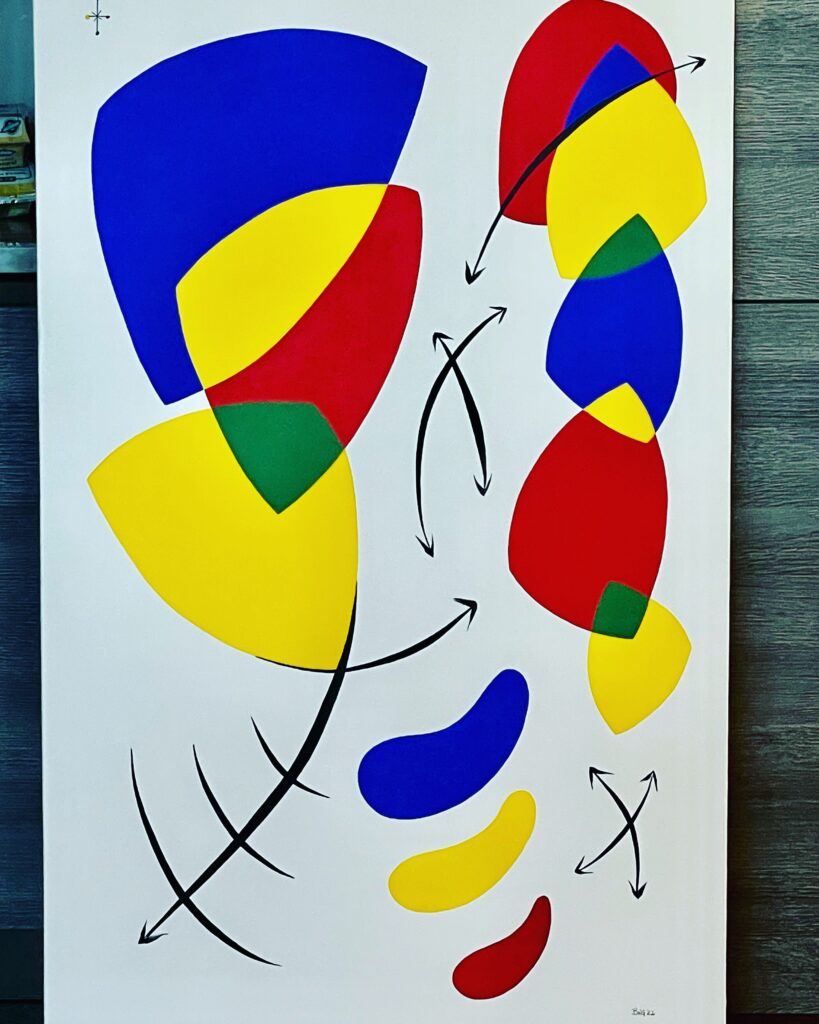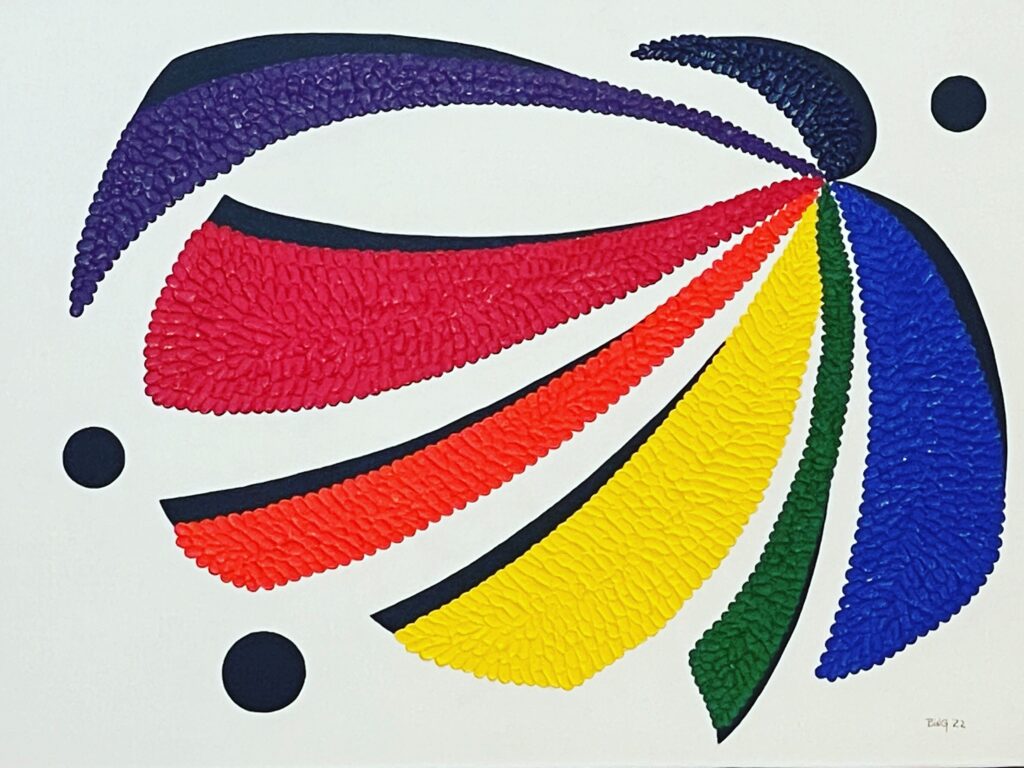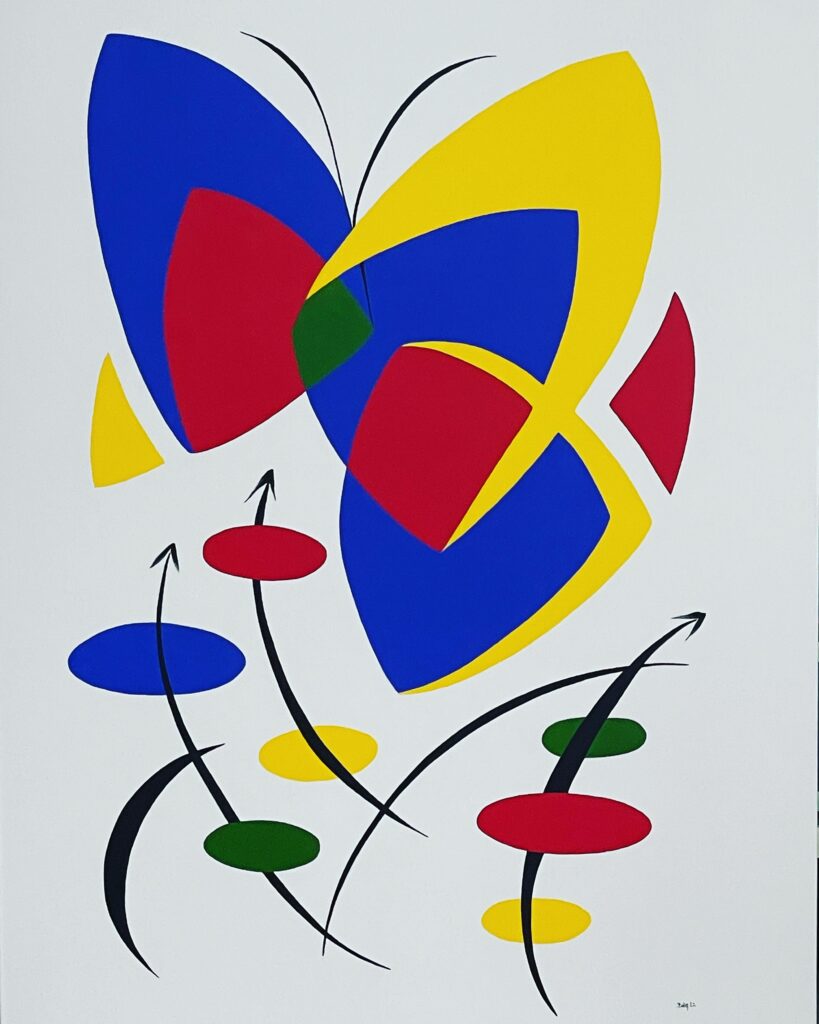When Jewish painter and goldsmith Bari Bing was in the midst of breast cancer treatment, there was one thing that kept her going: knowing that her father had survived imprisonment at Dachau. “If he could survive that, then I could survive this, for sure,” Bari told herself. The phrase almost became a mantra to her.
Nearly forty years later and now cancer-free, Bari has more than just survived. Just last week, Bari’s first solo exhibition in New York opened at the Saphira & Ventura Gallery. The show featured dozens of Bari’s paintings from her Spectrum series (which explore shape through the colors red, yellow and blue) and her Avian Series (a more recent development in Bari’s work which focuses more on texture and a feathered technique of layering paint). Across all her collections, her work showcases her signature brightly-colored and playful style, imbuing the viewer with a sense of optimism that might make it hard to imagine how much she’s gone through.
Bari recently chatted with Kveller about how her family’s Holocaust trauma inspires her artwork, her unconventional path in the art world and what’s next for her.
This interview has been edited and condensed for clarity.
Could you just tell me a bit about your Jewish identity and background?
I have a very, very strong Jewish identity. My mother was Jewish of Italian descent. She came from Padua in northern Italy. And my father was German-Jewish and grew up during the Second World War. It’s actually a very interesting story how he emigrated to America.
My father came from a town in southern Germany called Furth, which is by Munich. His family had a shoe and leather factory — they were very wealthy. He was the youngest of three children, and when he was born in 1911, his parents adopted a Jewish orphan to help take care of the other two children. In those days, they just did what they did. Her name was Rosa, and she was about 10 years old at that time. During the ’20s, Rosa immigrated to America to help her uncle who was not well.
So life goes on, and then the Anschluss happened and my father was arrested. He was in his 20s, and he was sent to Dachau. But he had applied for [the lottery for] immigration to America, as did the rest of the family, and his number came up while he was in Dachau. They allowed him to leave if he had somebody to sign for him in America. The only person he had was Rosa, whom his family had adopted years earlier. So Rosa signed for him.
He was in Dachau for about a year and a half. He came to America, met my mother, they got married and then I came along. I was brought up in a German-Jewish household in Lakewood, New Jersey and I spoke German with my father. In those days, Lakewood was not Orthodox. It was primarily second-generation Jews that were already established, or immigrant Jews. Most of them were Polish though, and my family was the only German family there — which was difficult because everybody spoke Yiddish, and I didn’t speak Yiddish. I actually wasn’t allowed to speak Yiddish; I spoke High German.
We were always looking for people who survived. My grandfather, my grandmother, my aunt, my uncle and my cousin all ended up either in Auschwitz or in Theresienstadt. My grandfather was given a special dispensation because he had fought for the Kaiser. He was allowed to stay in his house — I have a picture of them in Furth, no star on his arm or anything, with my cousin, who was about 9 years old at the time, like nothing. That must have been in the early ’40s. But then, at the very end, they were taken to Auschwitz and my cousin also died in Theresienstadt. I have letters from them. It’s heartbreaking to read these letters from when they were waiting for the lottery number to come up, and it just never happened. So I’ve kept them and will probably donate them to a museum eventually. But they’re part of my family’s history. That’s probably as much as I have from the family.
My father’s brother immigrated to Israel in the early 1930s. My cousins are in Israel. But growing up was difficult, and art seemed to have been my salvation. I was always drawing, painting, sketching until the early hours in the morning. I guess it was to escape a lot of that heavy, dark feeling of looking for survivors.
Is art still therapeutic for you?
I’m sure. When you grow up with a Holocaust survivor, they either do one of two things: They either ignore it completely, or they quasi-obsess over it. And my father was one of those quasi-obsessors, but that he survived is the most important thing. Growing up with that, there were things that happened that I realize now were almost a form of PTSD. I’ve spoken with counselors about it, too – I was in a second generation group for quite some time. It helps you to put [the Holocaust] in a framework that you can rationalize. But it’s always there. I’m 72 years old, and there are still things that I’m very aware of that other people aren’t. I’m always very aware, always very conscious of my surroundings, you know?
When I first started my professional art career, actually, I was a goldsmith. And I recently realized that [my career choice] was impacted by the Holocaust in a tremendous way, because I was taught to be self-sufficient. I always thought that if I could make jewelry and be good at it, then I could do that anywhere. I was at Syracuse University during the student riots in the ’70s around the Vietnam War, which sort of brought back memories of what my father had told me about riots and burning books and things like that. So I quit school and I applied to school in Switzerland, because I thought it was a safe place to be. I went to school for four years, where I studied goldsmithing, because I figured that way I could provide for myself, and I was self-sufficient. I did well and came back to the States when things had calmed down — I guess I matured a little bit and rationalized that people weren’t going to be knocking on my door. I started my own business in custom one-of-a-kind jewelry design.
And you know, it’s funny, because when I won these awards, I was concerned about bringing too much attention to myself. But now, having some level of notoriety from painting doesn’t faze me at all. I just want to bring more light to the world. [My paintings are] giving a lot of people energy and I’m feeling good by making people feel good. There’s enough darkness in the world as is, so I would like to bring more of that brightness and celebrate life and joy.
That’s wonderful. So how does it feel to have had your first solo exhibition at 72?
I’m a bit in awe of the whole experience. Not only did I have a solo show here, but I had one at the Biennale in Venice this past year in September. I had 18 pieces there, and they were primarily my early works. I had a tremendous response over there — everybody loved it, especially the Europeans. It’s bright, it’s fresh and it’s invigorating work. And the solo show in New York was also very successful. I ended up selling quite a few pieces there and even some pieces through Instagram. So I’m encouraged by this, and I want to keep going.
Was your family able to attend the exhibition?
My husband was there in Italy and my son wasn’t. But my son was able to come to the exhibit in New York. Now I’m now looking for galleries to represent me in Florida, [where I am now], because we have two residences. I’d like to have a gallery represent me down here because I keep painting. I just keep painting. Even though I’m 72, I don’t feel like I’m 72. It’s like, OK, I have a couple of aches and pains. But I’m still out there. I’m still up at 5:30 in the morning and going to sleep at 11:30 at night. And sometimes I even paint at 5:30 in the morning.
What a lovely way to start the day!
Yeah, it really is. I’m enjoying it a lot, and what makes me even happier is that other people are enjoying it, too. That’s a big thing for me.
Definitely. You’ve said that the bright and positive tone of your paintings is a result of your family’s Holocaust trauma and also your own trauma from surviving breast cancer. Can you elaborate on that?
I’m just so thankful to be alive. To say that life is beautiful is almost trite. But it’s true. I was inspired by artists like Calder and Mondrian, and their work is light and dark. It’s sort of happy work. It makes you feel enlightened and bright, and gives you inspiration to move forward. What kept me going when I had breast cancer was knowing that my father survived Dachau. And I had everything — I had chemo, radiation, the whole nine yards. It was very, very hard. And at that time, my son was two months old.
Oh my gosh.
So on top of that stresser, as well, it was difficult. But, like I said, I’m just so thankful to be alive now and happy that I can do this work.
So you started painting as a child, but started your career as a goldsmith. How did you get back into painting?
During COVID, one of my husband’s daughters moved from Manhattan to Florida. We missed the grandkids, so we decided to look for a place in Florida as well. We found one and did our renovations, and then it came time to put art on the wall. But we couldn’t find anything we really liked. We would go to galleries, and I would say, “There’s no way we’re paying that kind of money for somebody’s copy of 100 out of 500.” It was like looking at a cheap copy of a copy.
So I said to my husband, “I can do this.” And he knew I was a goldsmith, but he didn’t know that I could paint. I had some small nine by 12 canvases and some cheap paints and some brushes. And I started to paint.
Later, we went up to the Palm Beach art show, and Alcinda Saphira, the chief curator of Saphira & Ventura Gallery, had an exhibit there. We started talking and she said, “It sounds like you’re an artist.” And I said, “Well, I’ve painted a couple of paintings lately.” And she looked at me, and she said, “I would like to represent you in New York.” And I said, “OK!” So we got back to New York, and we worked out an agreement. I’m still pretty much awestruck over it.
I would say your path in the art world has been slightly unconventional. What advice would you give to women who are also interested in showing their art, but have had an unconventional path?
The most important thing is to get your work out there and show it. After I went out on my own in the jewelry-making business, I actually put my work in a store on consignment. I put a price on it, and if people bought it, that was fine. Well, what happened is people saw the work and they didn’t want to buy that. But they wanted something else from me. So it gave me an entree into that custom field. But I think it’s a whole different world of technology now, so Instagram has been helpful to me as well.
You had to pause your art career when you became a mother and dealt with breast cancer. Was there any part of you that was resentful of that?
No, it was never an issue that I was resentful. I had responsibilities. I had to take care of my son, and then my parents were not well, too. So I had to basically put everything on hold to take care of my son and take care of them. At that time, I was in a difficult situation because I had a real estate business as well. So I had to manage that. And then my first husband passed away. So I was sort of on autopilot just dealing with everything.
But I wasn’t resentful. Life happens, and then life happens again. I went from 13 years of a very difficult period to now, when everything is relatively simple for me. And now I’m getting back into it with painting, which is great.
So we’ve talked about how the shadow of the Holocaust affected your childhood and even your adulthood. Has that been present in your household, with your son?
I don’t know that it had any bearing on that, other than he knows his family history. And he has a tremendous sense of responsibility and a Jewish identity.
One more question: what future projects or exhibitions do you have?
One of my painting, “Papillon,” is now going to Egypt. It’s going to an exhibition in May of all female artists — I won’t be there though. And in terms of further projects, I’m still working on my Avian series. I’ve got a stack of sketches yet to put on canvas, and ideas just keep coming into my head. And I just keep painting. I just keep doing it, I love it.
